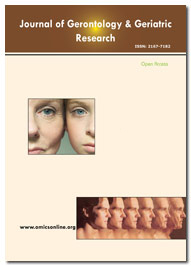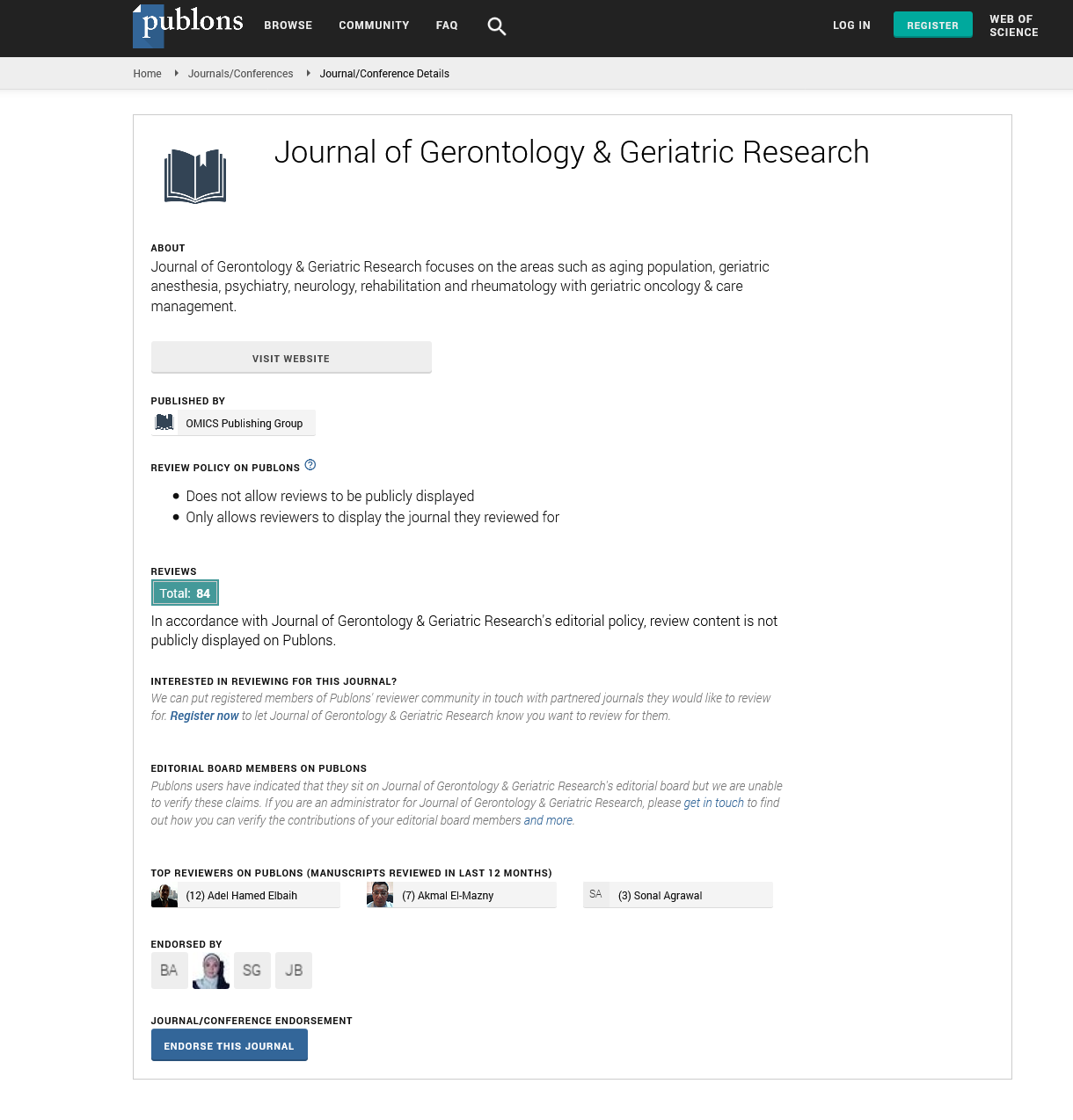Indexed In
- Open J Gate
- Genamics JournalSeek
- SafetyLit
- RefSeek
- Hamdard University
- EBSCO A-Z
- OCLC- WorldCat
- Publons
- Geneva Foundation for Medical Education and Research
- Euro Pub
- Google Scholar
Useful Links
Share This Page
Journal Flyer

Open Access Journals
- Agri and Aquaculture
- Biochemistry
- Bioinformatics & Systems Biology
- Business & Management
- Chemistry
- Clinical Sciences
- Engineering
- Food & Nutrition
- General Science
- Genetics & Molecular Biology
- Immunology & Microbiology
- Medical Sciences
- Neuroscience & Psychology
- Nursing & Health Care
- Pharmaceutical Sciences
Brief Report - (2024) Volume 13, Issue 4
Age-Related Chronic Diseases: A Global Perspective on Prevention and Treatment
Tang Gong*Received: 03-Aug-2024, Manuscript No. jggr-24-27609; Editor assigned: 05-Aug-2024, Pre QC No. P-27609; Reviewed: 17-Aug-2024, QC No. Q-27609; Revised: 23-Aug-2024, Manuscript No. R-27609; Published: 30-Aug-2024, DOI: 10.35248/2167-7182.2024.13.742
Introduction
As the global population ages at an unprecedented rate, the burden of age-related chronic diseases is becoming one of the most significant public health challenges of the 21st century. By 2050, the number of people aged 60 and older is expected to more than double, reaching over two billion worldwide. This demographic shift is largely driven by advancements in healthcare, improved living standards, and better management of infectious diseases, which have collectively led to longer life expectancies. However, these very successes in public health have also given rise to an increasing prevalence of chronic diseases that disproportionately affect older adults. Conditions such as cardiovascular disease, diabetes, osteoporosis, dementia, and arthritis are among the leading causes of morbidity and mortality in aging populations, and they represent a major strain on healthcare systems across the globe. Age-related chronic diseases not only diminish quality of life for individuals but also place a significant economic burden on societies, as the costs associated with managing these conditions—ranging from long-term care to expensive medical treatments—continue to rise [1]. This paper explores the global perspective on age-related chronic diseases, focusing on both the prevention and treatment strategies that can help address this growing public health concern. Through a deeper understanding of the causes and trends surrounding these diseases, we can begin to formulate solutions that will mitigate their impact on populations worldwide.
Description
Age-related chronic diseases are a diverse group of Non-Communicable Diseases (NCDs) that commonly emerge as individuals grow older. These conditions are often progressive, long-lasting, and frequently lead to significant disability or a diminished quality of life. The most prevalent chronic diseases associated with aging include cardiovascular diseases (such as hypertension, heart disease, and stroke), diabetes (particularly type 2), neurodegenerative disorders (such as Alzheimer’s disease and Parkinson’s disease), musculoskeletal diseases (like osteoarthritis and osteoporosis), and certain types of cancer [2]. The risk of developing these diseases increases as individuals age, due to a combination of biological, genetic, and environmental factors. As people grow older, their bodies experience a decline in essential physiological functions—such as a weakened immune system, slower cell regeneration, and a reduced capacity to repair tissues—making them more susceptible to chronic diseases. In addition, lifestyle factors such as poor diet, physical inactivity, smoking, excessive alcohol consumption, and chronic stress play a crucial role in accelerating the onset of these diseases. The mechanisms underlying age-related chronic diseases are complex and involve a multifaceted interaction between genetics, lifestyle choices, and environmental exposures. These diseases do not arise in isolation but often stem from cumulative risk factors accumulated over the course of an individual's life. In many high-income countries, significant advances in medical technology and healthcare infrastructure have enabled improved management and treatment of these diseases. However, the high costs of healthcare innovations, such as pharmaceuticals and advanced therapies, can limit access for some populations, creating disparities in health outcomes [3].
In contrast, low- and middle-income countries face unique challenges in dealing with the growing prevalence of chronic diseases. These nations often struggle to balance the prevention and treatment of non-communicable diseases with the continued need to address infectious diseases and other health priorities. Despite these challenges, there is a growing recognition that prevention, early intervention, and health promotion can help reduce the burden of age-related chronic diseases. Prevention strategies are gaining momentum worldwide, as governments, healthcare providers, and public health organizations work to address the root causes of these conditions. Lifestyle changes—such as encouraging regular physical activity, healthy eating, smoking cessation, and stress management—have proven effective in mitigating the risk factors associated with many chronic diseases. In addition, early detection through routine screenings for conditions like hypertension, diabetes, and certain cancers can help identify at-risk individuals before disease progression leads to more severe health outcomes. Community-based programs that focus on education, social support, and access to healthy environments have also demonstrated success in improving public health and reducing the incidence of chronic diseases among older populations [4,5].
Conclusion
The global rise in age-related chronic diseases presents a complex and multifaceted challenge that demands coordinated action at multiple levels. As the world’s population continues to age, it is critical to shift the focus from solely treating chronic conditions to prioritizing their prevention and early detection. Promoting healthy lifestyles, improving access to healthcare services, and investing in public health initiatives that encourage physical activity, healthy eating, and mental well-being are essential to reducing the incidence of these diseases. Additionally, addressing social determinants of health—such as socioeconomic status, access to nutritious food, and safe environments for physical activity—will be crucial in fostering healthier aging populations, particularly in regions where resources are limited. Governments, healthcare systems, and international organizations must work collaboratively to ensure that effective prevention and treatment strategies are accessible to all populations, regardless of income or geography. In low- and middle-income countries, where healthcare infrastructure is often underdeveloped, global partnerships and the sharing of knowledge, technology, and resources are essential to addressing the growing burden of age-related chronic diseases. By focusing on both prevention and equitable healthcare access, it is possible to reduce the impact of these conditions and improve the quality of life for older adults around the world. Ultimately, a proactive approach that encompasses lifestyle interventions, early intervention strategies, and healthcare reform will be the key to ensuring that older adults live healthier, longer lives. With sustained commitment and action, we can create a global framework for healthy aging that benefits individuals and societies alike.
Acknowledgement
None.
Conflict of Interest
None.
References
- Harvey RF, Bradshaw J. A simple index of Crohn's-disease activity. Lancet. 1980;315:514.
- Guo L, Rohde J, Farraye FA. Stigma and disclosure in patients with inflammatory bowel disease. Infl Bowel Dis. 2020;26:1010-1016.
- Touyz RM, de Baaij JH, Hoenderop JG. Magnesium disorders. N Engl J Med. 2024;390:1998-2009.
- Kirkland AE, Gabrielle LS, Kathleen FH. "The role of magnesium in neurological disorders." Nutrients 2018;10:730.
- Kurella M, Chertow GM, Luan J, Yaffe K. Cognitive impairment in chronic kidney disease. J Am Geriatr Soc. 2004;52:1863-1869.
Google Scholar, Crossref, Indexed at
Google Scholar, Crossref, Indexed at
Google Scholar, Crossref, Indexed at
Google Scholar, Crossref, Indexed at
Citation: Gong T (2024). Age-Related Chronic Diseases: A Global Perspective on Prevention and Treatment. J Gerontol Geriatr Res. 13: 742.
Copyright: © 2024 Gong T. This is an open-access article distributed under the terms of the Creative Commons Attribution License, which permits unrestricted use, distribution, and reproduction in any medium, provided the original author and source are credited.

